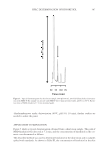COMPATIBILITY STUDIES IN BINARY MIXTURES OF AVOBENZONE 323 In the IR spectrum of avobenzone in nujol, the following bands were observed: 1605 (asym ring) 1305 (O-C-C) 1259 (C-O) 1229 1171, 1111, and 1035 (C-C) 844 and 788 (p-di subst.) cm-1. IR spectra of avobenzone and its blends with the above-mentioned excipients cetearyl alcohol, isopropyl myristate, diethylhexyl syringylidene malonate, glycerin, cetearyl alcohol/ ceteareth 20, cetearyl alcohol/sodium lauryl sulfate/sodium cetearyl sulfate, and paraffi num liquidum showed the presence of characteristic bands corresponding to avo- benzone. This suggests that avobenzone is kept unaltered in these blends. FT-IR spectrum of avobenzone–caprylic capric triglyceride blend did not present the characteristic bands of avobenzone at 1171, 1035, and 788 cm−1. FT-IR spectrum of Table II Temperature and Enthalpy Values of Binary Mixtures Avobenzone/Excipients Samples Tonset (°C) Tpeak (°C) ΔH (Jg-1) Ascorbyl palmitate 81.75 103.48 85.45 107.65 −39.99 −427.75 BHT 54.23 57.91 −70.02 Silicone 81.62 84.95 37.10 Paraffi num liquidum 71.62 78.84 −37.14 Acetylated lanolin 73.46 81.66 −15.30 Cetearylalcohol/ceteareth 20 49.56 60.81 52.36 71.24 −35.59 −20.45 Cetearylalcohol/sodium lauryl sulfate/sodium cetearyl sulfate 37.75 52.26 72.41 40.96 56.95 80.16 −7.24 −10.24 −72.89 Methylparaben 74.87 96.86 80.40 116.95 −47.76 −44.48 Propylparaben 67.51 73.82 −115.38 Imidazolidinyl urea 81.04 158.82 84.70 160.54 −27.68 −2.05 Propylene glycol 79.60 155.20 83.92 172.38 −40.40 −34.00 Sorbitol 70% 81.07 109.47 85.36 123.15 −24.62 −82.99 Cetearyl alcohol 37.65 53.42 63.56 42.69 56.48 70.82 −33.17 −71.99 −12.47 Glycerin 89.85 286.68 93.12 287.26 −26.97 −78.44 Isopropyl myristate 49.79 146.09 63.54 180.74 −17.78 −46.57 Disodium EDTA 82.17 246.59 85.49 251.05 −30.83 −45.50 Caprylic capric triglyceride 59.76 75.59 −15.44 Titanium dioxide/silica 84.94 88.58 −33.44 Diethylhexyl syringylidene malonate 59.06 75.58 −12.25
JOURNAL OF COSMETIC SCIENCE 324 avobenzone–propylparaben blend and avobenzone–BHT blend did not present the char- acteristic band of avobenzone at 1305 cm−1. On the basis of mentioned differences, it may be considered that avobenzone interacts with caprylic capric triglyceride, propylparaben, and BHT. Figure 3. DSC scan of avobenzone with BHT. Figure 2. DSC scan of avobenzone with ascorbyl palmitate.
Purchased for the exclusive use of nofirst nolast (unknown) From: SCC Media Library & Resource Center (library.scconline.org)





















































































